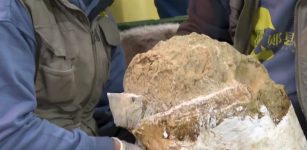8 Billion People: How Different The World Would Look If Neanderthals Had Prevailed
AncientPages.com - In evolutionary terms, the human population has rocketed in seconds. The news that it has now reached 8 billion seems inexplicable when you think about our history.
For 99% of the last million years of our existence, people rarely came across other humans. There were only around 10,000 Neanderthals living at any one time. Today, there are around 800,000 people in the same space that was occupied by one Neanderthal. What’s more, since humans live in social groups, the next nearest Neanderthal group was probably well over 100km away. Finding a mate outside your own family was a challenge.
Neanderthals were more inclined to stay in their family groups and were warier of new people. If they had outcompeted our own species (Homo sapiens), the density of population would likely be far lower. It’s hard to imagine them building cities, for example, given that they were genetically disposed to being less friendly to those beyond their immediate family.
The reasons for our dramatic population growth may lie in the early days of Homo sapiens more than 100,000 years ago. Genetic and anatomical differences between us and extinct species such as Neanderthals made us more similar to domesticated animal species. Large herds of cows, for example, can better tolerate the stress of living in a small space together than their wild ancestors who lived in small groups, spaced apart. These genetic differences changed our attitudes to people outside our own group. We became more tolerant.
Based on estimates by the History Database of the Global Environment and the UN. Max Roser, CC BY-SA
As Homo sapiens were more likely to interact with groups outside their family, they created a more diverse genetic pool which reduced health problems. Neanderthals at El Sidrón in Spain showed 17 genetic deformities in only 13 people, for example. Such mutations were virtually nonexistent in later populations of our own species.
But larger populations also increase the spread of disease. Neanderthals might have typically lived shorter lives than modern humans, but their relative isolation will have protected them from the infectious diseases that sometimes wiped out whole populations of Homo sapiens.
Putting more food on the table
Our species may also have had 10%-20% faster rates of reproduction than earlier species of human. But having more babies only increases the population if there is enough food for them to eat.
Our genetic inclination for friendliness took shape around 200,000 years ago. From this time onwards, there is archaeological evidence of the raw materials to make tools being moved around the landscape more widely.
From 100,000 years ago, we created networks along which new types of hunting weapons and jewellery such as shell beads could spread. Ideas were shared widely and there were seasonal aggregations where Homo sapiens got together for rituals and socialising. People had friends to depend on in different groups when they were short of food.
Similarities between modern humans and domesticated dogs, in contrast to archaic humans (here Neanderthal) and wild wolves. Theofanopoulou C PLoS ONE 12(10): e0185306, CC BY
And we may have also needed more emotional contact and new types of relationship outside our human social worlds. In an alternative world where Neanderthals thrived, it may be less likely that humans would have nurtured relationships with animals through domestication.
Dramatic shifts in environment
Things might also have been different had environments not generated so many sudden shortfalls, such as steep declines in plants and animals, on many occasions. If it wasn’t for these chance changes, Neanderthals may have survived.
Sharing resources and ideas between groups allowed people to live more efficiently off the land, by distributing more effective technologies and giving each other food at times of crisis. This was probably one of the main reasons why our species thrived when the climate changed while others died. Homo sapiens were better adapted to weather variable and risky conditions. This is partly because our species could depend on networks in times of crisis.
During the height of the last ice age around 20,000 years ago, temperatures across Europe were 8-10? degrees lower than today, with those in Germany being more like northern Siberia is now. Most of northern Europe was covered in ice for six-to-nine months of the year.
Social connections provided the means by which inventions could spread between groups to help us adapt. These included spear throwers to make hunting more efficient, fine needles to make fitted clothing and keep people warmer, food storage, and hunting with domesticated wolves. As a result, more people survived nature’s wheel of fortune.
Homo sapiens were generally careful not to overconsume resources like deer or fish, and were likely more aware of their lifecycles than much earlier species of human might have been. For example, people in British Columbia, Canada, only took males when they fished for salmon.
Depiction of a mammoth at Rouffignac Cave in France. Wikimedia Commons
In some cases, however, these lifecyles were hard to see. During the last ice age, animals such as mammoths, which roamed over huge territories invisible to human groups, went extinct. There are more than a hundred depictions of mammoths at Rouffignac in France dating to the time of their disappearance, which suggests people grieved this loss. But it is more likely mammoths would have survived if it wasn’t for the rise of Homo sapiens, because there would have been fewer Neanderthals to hunt them.
Too clever for our own good
Our liking for each other’s company and the way spending time together fosters our creativity was the making of our species. But it came at a price.
The more technology humankind develops, the more our use of it harms the planet. Intensive farming is draining our soils of nutrients, overfishing is wrecking the seas, and the greenhouse gases we release when we produce the products we now rely on are driving extreme weather. Overexploitation wasn’t inevitable but our species was the first to do it.
We can hope that visual evidence of the destruction in our natural world will change our attitudes in time. We have changed quickly when we needed to throughout our history. There is, after all, no planet B. But if Neanderthals had survived instead of us, we would never have needed one.
Written by Penny Spikins, Professor of the Archaeology of Human Origins, University of York
Provided by The Conversation
This article is republished from The Conversation under a Creative Commons license. Read the original article.
More From Ancient Pages
-
 Fossilized Million-Year-Old Human Skull Of Yunxian Man Excavated In China
Archaeology | Jan 10, 2023
Fossilized Million-Year-Old Human Skull Of Yunxian Man Excavated In China
Archaeology | Jan 10, 2023 -
 Khopesh Sword – Symbolic Weapon Of The Pharaohs And Emblem OF Egyptian Deities
Artifacts | May 27, 2021
Khopesh Sword – Symbolic Weapon Of The Pharaohs And Emblem OF Egyptian Deities
Artifacts | May 27, 2021 -
 Lazarus – An Obscure Biblical Figure
Biblical Mysteries | May 3, 2019
Lazarus – An Obscure Biblical Figure
Biblical Mysteries | May 3, 2019 -
 Carved Stone Depicting Mystery Horseman Unearthed At Roman Vindolanda, Hadrian’s Wall
Archaeology | Jul 1, 2021
Carved Stone Depicting Mystery Horseman Unearthed At Roman Vindolanda, Hadrian’s Wall
Archaeology | Jul 1, 2021 -
 Archaeologists Discover Mysterious Floor Made Of Bones In Alkmaar, Netherlands
Archaeology | Dec 23, 2024
Archaeologists Discover Mysterious Floor Made Of Bones In Alkmaar, Netherlands
Archaeology | Dec 23, 2024 -
 Archaeologists Highlight The Tartessos Culture’s Sustainable Construction Skills
Archaeology | Oct 4, 2024
Archaeologists Highlight The Tartessos Culture’s Sustainable Construction Skills
Archaeology | Oct 4, 2024 -
 Never-Before-Seen Object Found In The Skull Of Powerful Ancient Ruler Raises Many Questions
Featured Stories | Nov 12, 2024
Never-Before-Seen Object Found In The Skull Of Powerful Ancient Ruler Raises Many Questions
Featured Stories | Nov 12, 2024 -
 Hidden Mega-Monument Discovered At Laona, An Ancient Burial Mound In Cyprus
Archaeology | Aug 15, 2022
Hidden Mega-Monument Discovered At Laona, An Ancient Burial Mound In Cyprus
Archaeology | Aug 15, 2022 -
 Mystery Of Great Wall Of California: An Ancient Unsolved Enigma
Civilizations | Sep 11, 2018
Mystery Of Great Wall Of California: An Ancient Unsolved Enigma
Civilizations | Sep 11, 2018 -
 Ancient City Filled With Treasures May Be Hidden Underground In South America
Ancient Mysteries | Jul 20, 2018
Ancient City Filled With Treasures May Be Hidden Underground In South America
Ancient Mysteries | Jul 20, 2018 -
 Francis Drake, Queen’s Pirate And One Of The Founders Of English Naval Force
History | Apr 12, 2020
Francis Drake, Queen’s Pirate And One Of The Founders Of English Naval Force
History | Apr 12, 2020 -
 On This Day In History: Mysterious Death Of White Queen Anne Neville – On Mar 16, 1485
News | Mar 16, 2017
On This Day In History: Mysterious Death Of White Queen Anne Neville – On Mar 16, 1485
News | Mar 16, 2017 -
 Mediterranean Migration Was Low Over 8,000 Years – New Study
Archaeology | Mar 3, 2021
Mediterranean Migration Was Low Over 8,000 Years – New Study
Archaeology | Mar 3, 2021 -
 Çatalhöyük – 9,000 Years Ago: Overcrowding, Infectious Diseases, Violence And Environmental Problems Of Early Farmers
Archaeology | Jun 18, 2019
Çatalhöyük – 9,000 Years Ago: Overcrowding, Infectious Diseases, Violence And Environmental Problems Of Early Farmers
Archaeology | Jun 18, 2019 -
 Archaeology Illuminates Chinese Businesses In Eugene
Archaeology | May 23, 2022
Archaeology Illuminates Chinese Businesses In Eugene
Archaeology | May 23, 2022 -
 15 New Archaeological Finds Unearthed In Pre-Inca Ruins Of Tiwanaku, Bolivia
Artifacts | Jan 27, 2021
15 New Archaeological Finds Unearthed In Pre-Inca Ruins Of Tiwanaku, Bolivia
Artifacts | Jan 27, 2021 -
 On This Day In History: Agatha Christie Known As ‘Queen Of Crime’ Died – On Jan 12, 1976
News | Jan 12, 2017
On This Day In History: Agatha Christie Known As ‘Queen Of Crime’ Died – On Jan 12, 1976
News | Jan 12, 2017 -
 Freemasons Secrets – American Democracy Is Part Of An Ancient Universal Plan – The Beginning And The Dream Of A Brotherhood Of Men – Part 1
Ancient Mysteries | Jul 12, 2018
Freemasons Secrets – American Democracy Is Part Of An Ancient Universal Plan – The Beginning And The Dream Of A Brotherhood Of Men – Part 1
Ancient Mysteries | Jul 12, 2018 -
 Enormous And Impressive Derawar Fort, Bahawalpur, Pakistan Will Be Restored
News | Sep 14, 2015
Enormous And Impressive Derawar Fort, Bahawalpur, Pakistan Will Be Restored
News | Sep 14, 2015 -
 Queen Elizabeth I Was Identified As Author Of Tacitus’s Annales Translation
News | Dec 1, 2019
Queen Elizabeth I Was Identified As Author Of Tacitus’s Annales Translation
News | Dec 1, 2019




